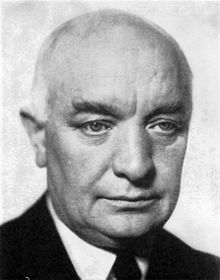Per Albin Hansson
Per Albin Hansson | |
|---|---|
 | |
| Prime Minister of Sweden | |
| In office 24 September 1932 – 19 June 1936 | |
| Monarch | Gustav V |
| Preceded by | Felix Hamrin |
| Succeeded by | Axel Pehrsson-Bramstorp |
| Prime Minister of Sweden | |
| In office 28 September 1936 – 6 October 1946 | |
| Monarch | Gustav V |
| Preceded by | Axel Pehrsson-Bramstorp |
| Succeeded by | Tage Erlander |
| Minister for Defence Ministers for War between 10 March - 30 June 1920 | |
| In office 10 March 1920 – 27 October 1920 | |
| Prime Minister | Hjalmar Branting |
| Preceded by | Erik Nilsson |
| Succeeded by | Carl Gustaf Hammarskjöld |
| In office 13 October 1921 – 19 April 1923 | |
| Prime Minister | Hjalmar Branting |
| Preceded by | Otto Lybeck |
| Succeeded by | Carl Malmroth |
| In office 18 October 1924 – 7 June 1926 | |
| Prime Minister | Hjalmar Branting, Rickard Sandler |
| Preceded by | Carl Malmroth |
| Succeeded by | Gustav Rosén |
| Personal details | |
| Born | October 28, 1885 Kulladal, Skåne, Sweden |
| Died | October 6, 1946 (aged 60) Stockholm, Sweden |
| Political party | Social Democrats |
| Spouse | Elisabeth Fryckberg |
| Cabinet | Cabinet of Per Albin Hansson I, II, III, IIII |
Per Albin Hansson (28 October 1885 in Kulladal – 6 October 1946 in Stockholm), leader of the Swedish Social Democrats, was a Prime Minister in four governments between 1932 and 1946, including the coalition government which was formed during World War II, and included all major parties except the Communists.
Politics
Politically Hansson advocated and worked for the introduction of a welfare state system, which he called Folkhemmet (the People's Home). Hansson died in Stockholm on 6 October 1946 of a heart-attack he suffered while stepping off a tram at the Ålstens Gård station, after traveling home, as he always did, as an ordinary passenger on a tram. He is interred in Norra begravningsplatsen in Stockholm.
World War II
Sweden was neutral during World War II, but cooperated and traded with both sides. Winston Churchill claimed that Sweden during WWII ignored the greater moral issues and played both sides for profit[1] In Swedish social democratic circles Per Albin is regarded highly today.[citation needed]
The 1941 "Midsummer Crisis"
After the German invasion of the Soviet Union in early summer of 1941; Operation Barbarossa, the Germans in June 22 asked Sweden for some military concessions. The Swedish government granted these requests for logistical support. (mainly German troop transports between Finland, occupied Norway, occupied Denmark) In Sweden the political deliberations surrounding this decision have been called the "midsummer crisis". Recent research by Carl-Gustaf Scott argues however that there never was a "crisis", and that
- "the crisis was created in historical hindsight in order to protect the political legacy of the Social Democratic Party and its leader Per Albin Hansson."[2]
Trade with the Axis and the Allies
To melt the steel required by the German Ruhr industry Germany was in 1939 - 1940 dependent on shipments of Swedish Iron ore since access to the supplies from the mines in France, the traditional supplier, were cut off until the invasion of France. In 1939 - 1940 the Allies tried various ways to stop the shipments of Swedish ore, for example by mining Norwegian territorial waters. (see Plan R 4)
Also payments from the Allies reached in agreement to stop the sale of steel to Nazi Germany were broken[citation needed], and the Germans were charged extortionate 'smugglers rates' for the steel.[citation needed]
The sale of steel and machined parts to Hitler's Germany undoubtedly prolonged the war against Russia where tanks played a prime role.
A downed stray V2 rocket was also sold to the Allies in 1942, passing details of advanced nazi rocket engineering over. In effect, the main political priority was to avoid direct war engagement of Sweden during WWII. During the later (after 1942) stages of WWII, Sweden was no longer seriously threatened by invasion from the third Reich.
Political legacy
In Swedish socialist circles Per Albin is still highly regarded. At the time many on the left wing regarded him as a traitor siding with the Nazis.
-
The birthplace of Per Albin Hansson
-
Per Albin Hansson in his youth
-
Communist caricature of Per Albin Hansson, portraying his transition from anti-militarist agitator to defense minister
-
The newly appointed Swedish cabinet, assembled outside the Royal Palace in Stockholm, December 13, 1939.
See also
References
- ^ Winston Churchill - The Second World War. ISBN 978-0712667029
- ^ From the abstract of: Carl-Gustaf Scott, "The Swedish Midsummer Crisis of 1941: The Crisis that Never Was" Journal of Contemporary History, Vol. 37, No. 3, 371-394 (2002) (SAGE JOURNALS ONLINE)
External links
- Wikipedia neutral point of view disputes from July 2009
- Articles lacking sources from December 2007
- 1885 births
- 1946 deaths
- People from Malmö Municipality
- Prime Ministers of Sweden
- Swedish Ministers for Defence
- Leaders of the Swedish Social Democratic Party
- Swedish people of World War II
- World War II political leaders
- Members of the parliament of Sweden
- People from Malmö
- Swedish democracy activists
- Swedish Lutherans
- Members of the Executive of the Labour and Socialist International





